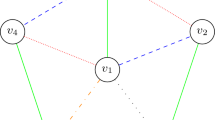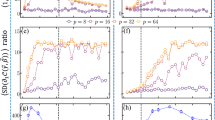Abstract
Quantum approximate optimization algorithms are hybrid quantum-classical variational algorithms designed to approximately solve combinatorial optimization problems such as the MAX-CUT problem. In spite of its potential for near-term quantum applications, it has been known that quantum approximate optimization algorithms have limitations for certain instances to solve the MAX-CUT problem, at any constant level p. Recently, the recursive quantum approximate optimization algorithm, which is a non-local version of quantum approximate optimization algorithm, has been proposed to overcome these limitations. However, it has been shown by mostly numerical evidences that the recursive quantum approximate optimization algorithm outperforms the original quantum approximate optimization algorithm for specific instances. In this paper, we analytically prove that the recursive quantum approximate optimization algorithm is more competitive than the original one to solve the MAX-CUT problem for complete graphs with respect to the approximation ratio.



Similar content being viewed by others
Data availability
Our manuscript has no associated data.
References
Preskill, J.: Quantum computing in the NISQ era and beyond. Quantum 2, 79 (2018)
Farhi, E., Goldstone, J., Gutmann, S.: A quantum approximate optimization algorithm. arXiv:1411.4028
Hastings, M.B.: Classical and quantum bounded depth approximation algorithms. arXiv:1905.07047
Bravyi, S., Kliesch, A., König, R., Tang, E.: Obstacles to state preparation and variational optimization from symmetry protection. Phys. Rev. Lett. 125, 260504 (2020)
Farhi, E., Goldstone, J., Gutmann, S.: The quantum approximate optimization algorithm needs to see the whole graph: a typical case. arXiv:2004.09002
Marwaha, K.: Local classical max-cut algorithm outperforms \(p = 2\) QAOA on high-girth regular graphs. Quantum 5, 437 (2021)
Barak, B., Marwaha, K.: Classical algorithms and quantum limitations for maximum cut on high-girth graphs. arXiv:2106.05900
Bravyi, S., Gosset, D., Grier, D., Schaeffer, L.: Classical algorithms for forrelation. arXiv:2102.06963
Bravyi, S., Kliesch, A., König, R., Tang, E.: Hybrid quantum-classical algorithms for approximate graph coloring. Quantum 6, 678 (2022)
Wang, Z., Hadfield, S., Jiang, Z., Rieffel, E.G.: Quantum approximate optimization algorithm for maxcut: a fermionic view. Phys. Rev. A 97, 022304 (2018)
Patel, Y.J., Jerbi, S., Bäck, T., Dunjko, V.: Reinforcement learning assisted recursive qaoa. arXiv:2207.06294
Acknowledgements
E.B. thanks Kunal Marwaha for helpful discussions. This work was supported by the National Research Foundation of Korea (NRF) grant funded by the Ministry of Science and ICT (MSIT) (No. NRF-2022M3K2A1083859 and No. NRF-2022R1C1C2006396). S.L. acknowledges support from the MSIT, Korea, under the Information Technology Research Center support program (No. IITP-2022-2018-0-01402) supervised by the Institute for Information and Communications Technology Planning and Evaluation and Creation of the Quantum Information Science R &D Ecosystem (No. 2022M3H3A106307411) through the NRF funded by the MSIT.
Author information
Authors and Affiliations
Corresponding author
Ethics declarations
Conflict of interest
The authors declare that they have no conflicts of interest.
Additional information
Publisher's Note
Springer Nature remains neutral with regard to jurisdictional claims in published maps and institutional affiliations.
Appendix: The positivity of the function g(t)
Appendix: The positivity of the function g(t)
In this appendix, we want to show that for all \(t\in [0,1]\),
To find the minimum of g(t), we consider the equation
Since g is continuous, we need to see that \(g(0)>0\), \(g(1) >0\), and \(g(t^*)>0\) for all critical points \(t^* \in \left[ 0,1\right] \).
Observe that
For any critical point \(t^* \in (0,1)\), it is clear that
that is,
Now, by imposing the condition in Eq. (11) on the function g, we have
If we regard the third term in Eq. (12) as a function of \(t^*\), we can easily see that it is decreasing on (0, 1). Therefore,
for all \(n \ge 4\). Hence \(g(t)>0\) for all \(t \in [0,1]\) when \(n \ge 4\).
For \(n<4\), we can prove that \(g(t)>0\) on [0, 1] from direct calculations as follows. When \(n=2\), g(t) becomes
since it can easily be shown that g(t) is increasing on [0, 1] and \(g(0)=4>0\). When \(n=3\), g(t) becomes
and we can show that it is concave on [0, 1] and \(g(0)=g(1)=4>0\). Thus, \(g(t)>0\) on the interval [0, 1].
Rights and permissions
Springer Nature or its licensor (e.g. a society or other partner) holds exclusive rights to this article under a publishing agreement with the author(s) or other rightsholder(s); author self-archiving of the accepted manuscript version of this article is solely governed by the terms of such publishing agreement and applicable law.
About this article
Cite this article
Bae, E., Lee, S. Recursive QAOA outperforms the original QAOA for the MAX-CUT problem on complete graphs. Quantum Inf Process 23, 78 (2024). https://doi.org/10.1007/s11128-024-04286-0
Received:
Accepted:
Published:
DOI: https://doi.org/10.1007/s11128-024-04286-0




